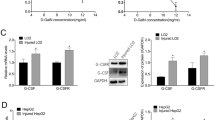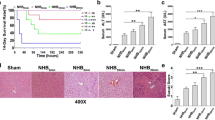Abstract
Background and aim
Acute hepatic insult triggers regeneration. If acute-on-chronic liver failure (ACLF) patients have a poorer regenerative response than acute liver failure (ALF) patients, and if so, the mechanisms underlying this, are not well understood.
Methods
We investigated the status of hepatocyte proliferation, hepatic progenitor cell (HPC) mediated regeneration, non-parenchymal cells (through immunohistochemistery), cytokines and growth factors (cytokine bead array) in liver and peripheral blood of ACLF (n = 29) and ALF (n = 17) patients. Liver endothelial cells, mesenchymal cells and Kupffer cells were isolated from explant livers and analysis of regenerative factors was done by qRT-PCR.
Results
Unlike ALF, the ACLF livers showed decreased hepatocyte proliferation (p < 0.001) and profound ductular-reaction with increased CK19 + hepatocytes (p < 0.0001). However, only decrease in Ki67+ hepatocytes was associated with 28 day mortality in ACLF (p < 0.001; HR = 0.78; 95% CI 0.69–0.88). In both groups, increase in plasma hepatocyte growth factor (HGF) (OR = 21.87 p = 0.002;), macrophage colony stimulating factor (MCSF) (OR = 21.73; p = 0.002) and stromal derived factor (SDF1)(OR = 10.2; p = 0.001) were associated with hepatocyte proliferation and decreased (> fivefolds) levels were associated with poor hepatocyte regeneration in ACLF patients. ACLF livers showed decrease in endothelial cells (p < 0.01) and expression of regenerative angiocrine factors C-X-C chemokine receptor type 7 (CXCR7), Inhibitor of DNA Binding 1(IDI) and HGF compared to ALF. In co-culture, while ALF liver mesenchymal stromal cells (LMSCs) induced the expression of CXCR7, IDI and HGF in human umbilical cord endothelial cells (HUVECs), the ACLF LMSCs were defective and showed decreased production of SDF-1, HGF and MCSF compared to ALF.
Conclusions
Decrease in hepatic endothelial cells and their regenerative angiocrine functions indicated by defective CXCR7-ID1 dependent HGF expression underlie the poor hepatocyte proliferation in ACLF compared to ALF patients. A robust hepatocyte self-replication is lacking in the livers of ACLF patients and is associated with poor survival.




Similar content being viewed by others

References
Byass P. The global burden of liver disease: a challenge for methods and for public health. BMC Med 2014;12:159
Rutherford A, Chung RT. Acute liver failure: mechanisms of hepatocyte injury and regeneration. Semin Liver Dis 2008;2:167–174
Forbes SJ, Rosenthal N. Preparing the ground for tissue regeneration: from mechanism to therapy. Nat Med 2014;8:857–869
Sarin SK, Choudhury A. Acute-on-chronic liver failure: terminology, mechanisms and management. Nat Rev Gastroenterol Hepatol 2016;3:131–149
Michalopoulos GK. Liver regeneration after partial hepatectomy: critical analysis of mechanistic dilemmas. Am J Pathol 2010;176:2–13
Bird TG, Lorenzini S, Forbes SJ. Activation of stem cells in hepatic diseases. Cell Tissue Res 2008;1:283–300
Bernal W, Hyyrylainen A, Gera A, Audimoolam VK, McPhail MJ, Auzinger G, et al. Lessons from look-back in acute liver failure? A single centre experience of 3300 patients. J Hepatol 2013;1:74–80
Sarin SK, Kumar A, Almeida JA, Chawla YK, Fan ST, Garg H, et al. Acute-on-chronic liver failure: consensus recommendations of the Asian Pacific Association for the study of the liver (APASL). Hepatol Int 2009;1:269–282
Boulton R, Woodman A, Calnan D, Selden C, Tam F, Hodgson H. Nonparenchymal cells from regenerating rat liver generate interleukin-1alpha and -1beta: a mechanism of negative regulation of hepatocyte proliferation. Hepatology 1997;1:49–58
Boulton RA, Alison MR, Golding M, Selden C, Hodgson HJ. Augmentation of the early phase of liver regeneration after 70% partial hepatectomy in rats following selective Kupffer cell depletion. J Hepatol 1998;2:271–280
Meijer C, Wiezer MJ, Diehl AM, Schouten HJ, Schouten HJ, Meijer S, et al. Kupffer cell depletion by CI2MDP-liposomes alters hepatic cytokine expression and delays liver regeneration after partial hepatectomy. Liver 2000;1:66–77
Goh YP, Henderson NC, Heredia JE, Red Eagle A, Odegaard JI, Lehwald N, et al. Eosinophils secrete IL-4 to facilitate liver regeneration. Proc Natl Acad Sci USA 2013;110:9914–9919
Michalopoulos GK, DeFrances MC. Liver regeneration. Science 1997;276:60–66
Rastogi A, Maiwall R, Bihari C, Trehanpati N, Pamecha V, Sarin SK. Two-tier regenerative response in liver failure in humans. Virchows Arch 2014;464:565–573
Lee WM, Squires RH Jr, Nyberg SL, Doo E, Hoofnagle JH. Acute liver failure: summary of a workshop. Hepatology 2008;47:1401–1415
Sarin SK, Kedarisetty CK, Abbas Z, Amarapurkar D, Bihari C, Chan AC, et al. Acute-on-chronic liver failure: consensus recommendations of the Asian Pacific Association for the Study of the Liver (APASL). Hepatol Int 2014;8:453–471
Ding BS, Nolan DJ, Butler JM, James D, Babazadeh AO, Rosenwaks Z, et al. Inductive angiocrine signals from sinusoidal endothelium are required for liver regeneration. Nature 2010;468:310–315
Boulter L, Govaere O, Bird TG, Radulescu S, Ramachandran P, Pellicoro A, et al. Macrophage-derived Wnt opposes Notch signaling to specify hepatic progenitor cell fate in chronic liver disease. Nat Med 2012;18:572–579
Raven A, Lu WY, Man TY, Ferreira-Gonzalez S, O’Duibhir E, Dwyer BJ, et al. Cholangiocytes act as facultative liver stem cells during impaired hepatocyte regeneration. Nature 2017;547:350–354
Lowes KN, Brennan BA, Yeoh GC, Olynyk JK. Oval cell numbers in human chronic liver diseases are directly related to disease severity. Am J Pathol 1999;154:537–541
Libbrecht L, Desmet V, Van Damme B, Roskams T. The immunohistochemical phenotype of dysplastic foci in human liver: correlation with putative progenitor cells. J Hepatol 2000;33:76–84
Roskams T. Progenitor cell involvement in cirrhotic human liver diseases: from controversy to consensus. J Hepatol 2003;39:431–434
Wendum D, Layese R, Ganne-Carrié N, Bourcier V, Merabtene F, Cagnot C, et al. Influence of progenitor-derived regenerative markers on hepatitis C virus-related cirrhosis outcome (ANRS CO12 CirVir cohort). Hepatology 2018;68(4):1534–1548
Español-Suñer R, Carpentier R, Van Hul N, Legry V, Achouri Y, Cordi S, et al. Liver progenitor cells yield functional hepatocytes in response to chronic liver injury in mice. Gastroenterology 2012;143:1564–1575
Malato Y, Naqvi S, Schürmann N, Ng R, Wang B, Zape J, et al. Fate tracing of mature hepatocytes in mouse liver homeostasis and regeneration. J Clin Invest 2011;121:4850–4860
Rodrigo-Torres D, Affò S, Coll M, Morales-Ibanez O, Millán C, Blaya D, et al. The biliary epithelium gives rise to liver progenitor cells. Hepatology 2014;60:1367–1377
Schaub JR, Malato Y, Gormond C, Willenbring H. Evidence against a stem cell origin of new hepatocytes in a common mouse model of chronic liver injury. Cell Rep 2014;8:933–939
Tarlow BD, Pelz C, Naugler WE, Wakefield L, Wilson EM, Finegold MJ, et al. Bipotential adult liver progenitors are derived from chronically injured mature hepatocytes. Cell Stem Cell 2014;15:605–618
Yanger K, Knigin D, Zong Y, Maggs L, Gu G, Akiyama H, et al. Adult hepatocytes are generated by self-duplication rather than stem cell differentiation. Cell Stem Cell 2014;15:340–349
Font-Burgada J, Shalapour S, Ramaswamy S, Hsueh B, Rossell D, Umemura A, et al. Hybrid periportal hepatocytes regenerate the injured liver without giving rise to cancer. Cell 2015;162:766–779
Yanger K, Zong Y, Maggs LR, Shapira SN, Maddipati R, Aiello NM, et al. Robust cellular reprogramming occurs spontaneously during liver regeneration. Genes Dev 2013;27:719–724
Yimlamai D, Christodoulou C, Galli GG, Yanger K, Pepe-Mooney B, Gurung B, et al. Hippo pathway activity influences liver cell fate. Cell 2014;157:1324–1338
Ding BS, Cao Z, Lis R, Nolan DJ, Guo P, Simons M, et al. Divergent angiocrine signals from vascular niche balance liver regeneration and fibrosis. Nature 2014;505:97–102
Rafii S, Cao Z, Lis R, Siempos II, Chavez D, Shido K, et al. Platelet-derived SDF-1 primes the pulmonary capillary vascular niche to drive lung alveolar regeneration. Nat Cell Biol 2015;2:123–136
Marra F, Tacke F. Roles for chemokines in liver disease. Gastroenterology 2014;147:577–594
Mavier P, Martin N, Couchie D, Préaux AM, Laperche Y, Zafrani ES. Expression of stromal cell-derived factor-1 and of its receptor CXCR36 in liver regeneration from oval cells in rat. Am J Pathol 2004;165:1969–1977
Bruno S, Herrera Sanchez MB, Pasquino C, Tapparo M, Cedrino M, Tetta C, et al. Human liver-derived stem cells improve fibrosis and inflammation associated with nonalcoholic steatohepatitis. Stem Cells Int 2019;2019:6351091
Lin BL, Chen JF, Qiu WH, Wang KW, Xie DY, Chen XY, et al. Allogeneic bone marrow-derived mesenchymal stromal cells for hepatitis B virus-related acute-on-chronic liver failure: a randomized controlled trial. Hepatology 2017;66:209–219
Acknowledgements
We extend thanks to Department of Pathology for allowing platform for histopathological analysis. We also thank the funding agency Department of Biotechnology, Government of India for financial support (BT/PR8251/MED/31/218/2013).
Author information
Authors and Affiliations
Corresponding authors
Ethics declarations
Conflict of interest
Smriti Shubham, Dhananjay Kumar, Sheetalnath Rooge, Jaswinder Sing Maras, Deepanshu Maheshwari, Nidhi Nautiyal, Rekha Kumari, Adil Bhat, Guresh Kumar, Archana Rastogi, Senthil Kumar, Viniyendra Pamecha, Rakhi Maiwall, Chhagan Bihari, Anupam Kumar and Shiv K. Sarin to have no conflict of interest.
Ethical approval
All human tissue and blood samples were collected with prior approval from Institutional Research Ethics Committee (F25/5/43/ILBS/2013/IEC/IRB No: 21/6) and informed patient’s consent.
Additional information
Publisher's Note
Springer Nature remains neutral with regard to jurisdictional claims in published maps and institutional affiliations.
Electronic supplementary material
Below is the link to the electronic supplementary material.
Rights and permissions
About this article
Cite this article
Shubham, S., Kumar, D., Rooge, S. et al. Cellular and functional loss of liver endothelial cells correlates with poor hepatocyte regeneration in acute-on-chronic liver failure. Hepatol Int 13, 777–787 (2019). https://doi.org/10.1007/s12072-019-09983-y
Received:
Accepted:
Published:
Issue Date:
DOI: https://doi.org/10.1007/s12072-019-09983-y



